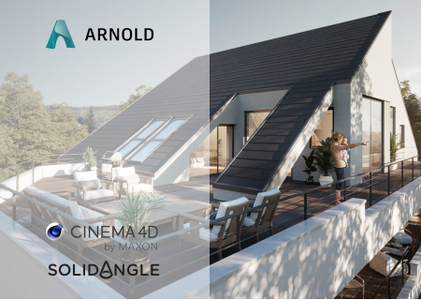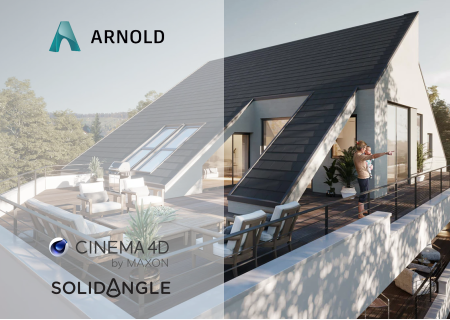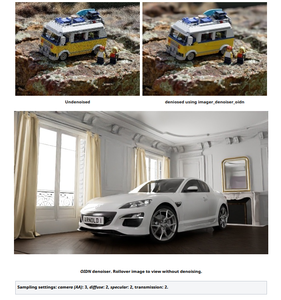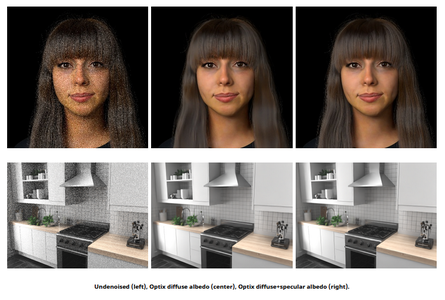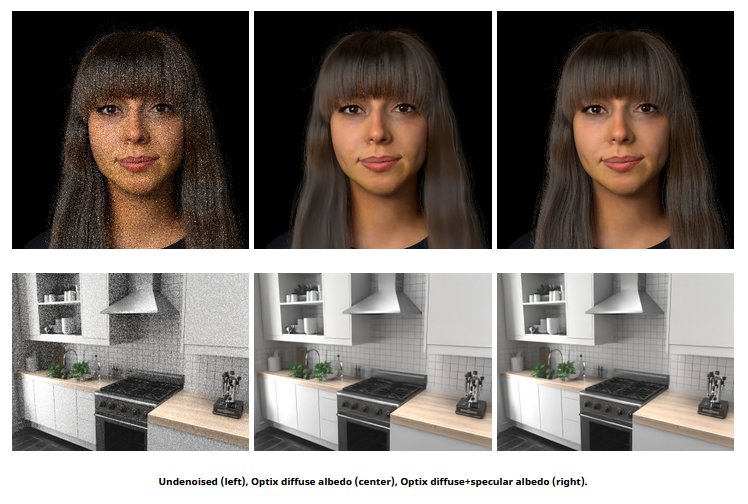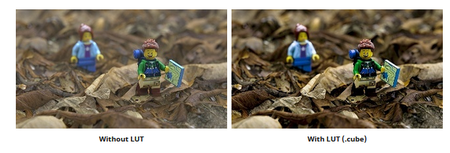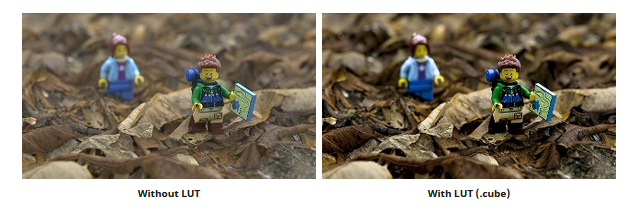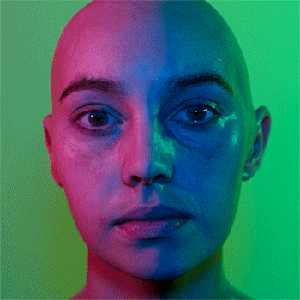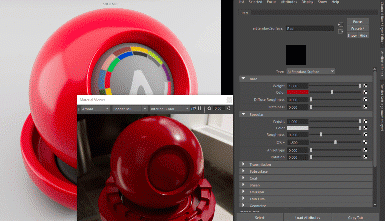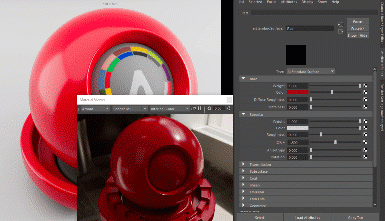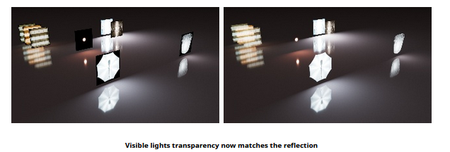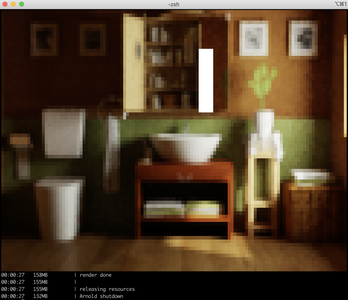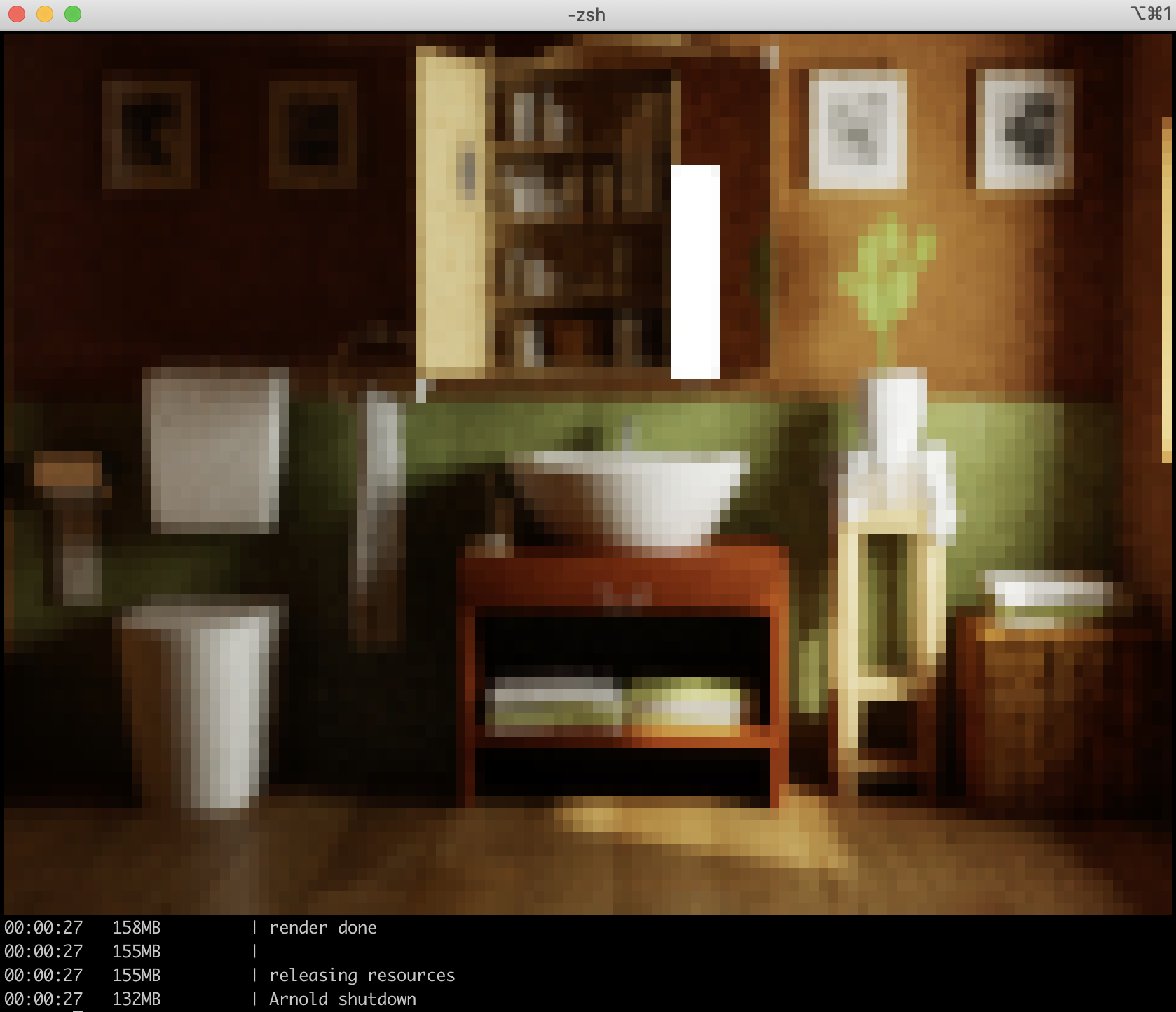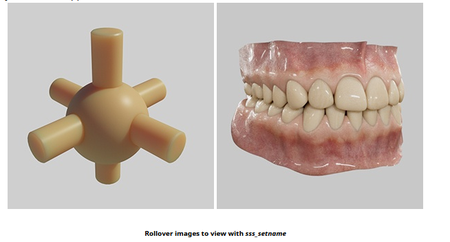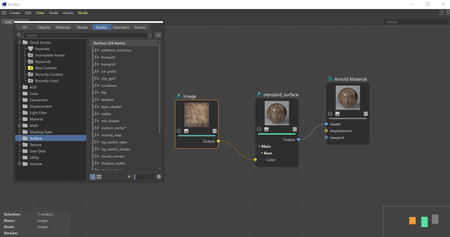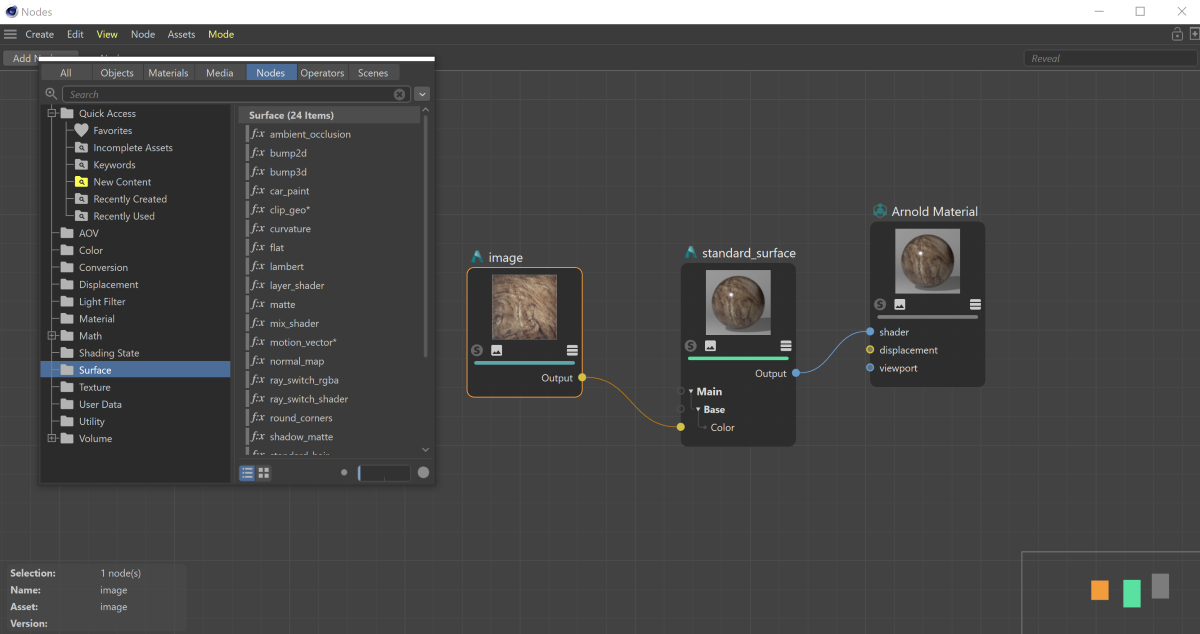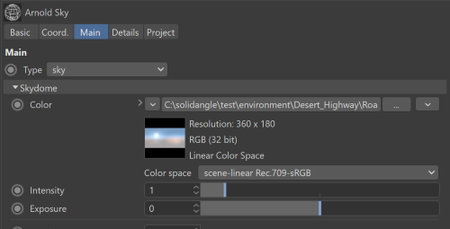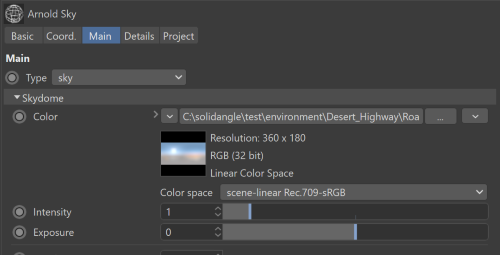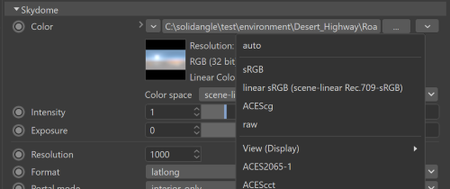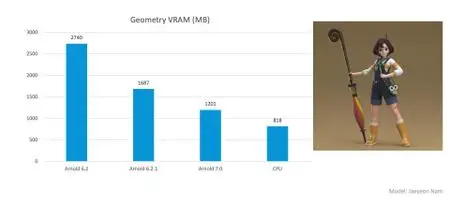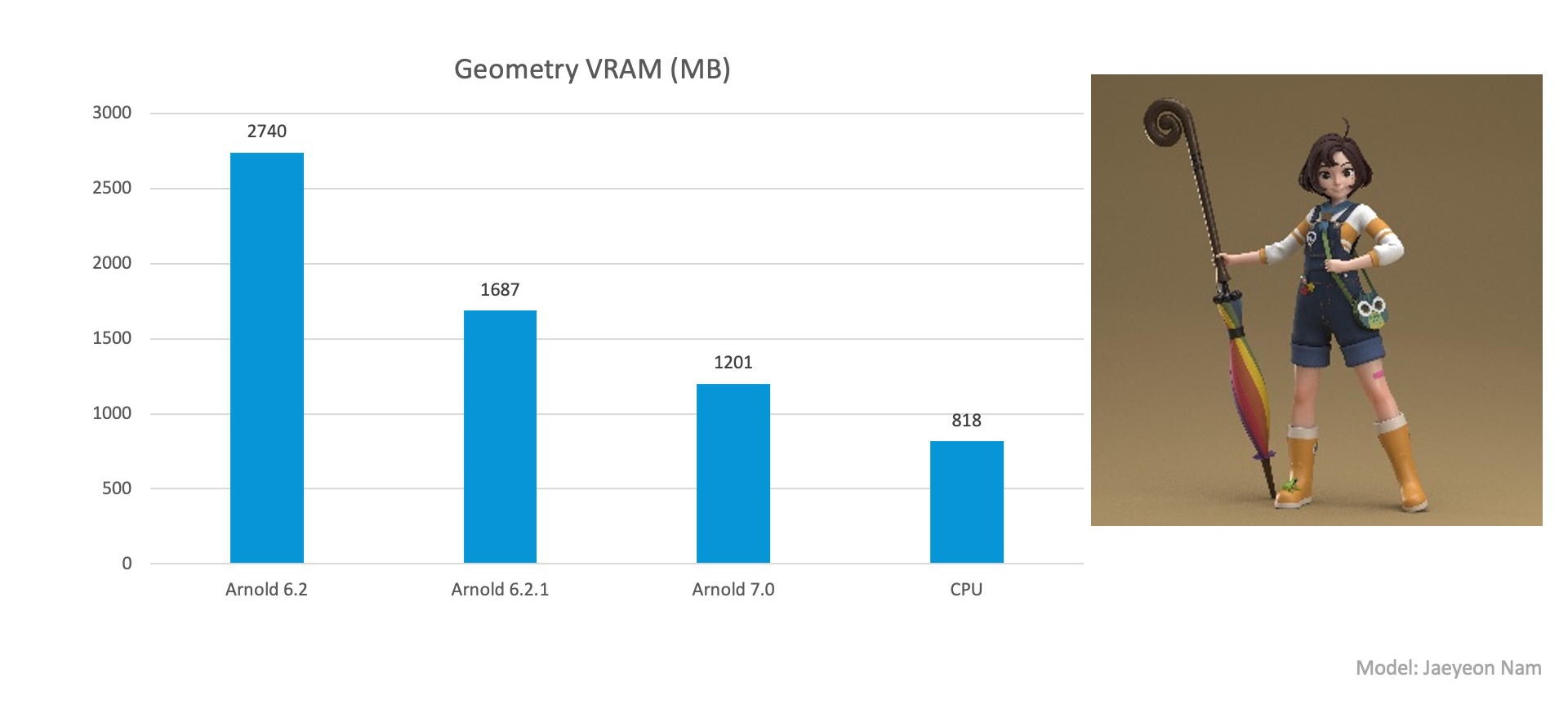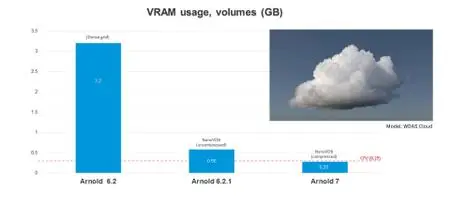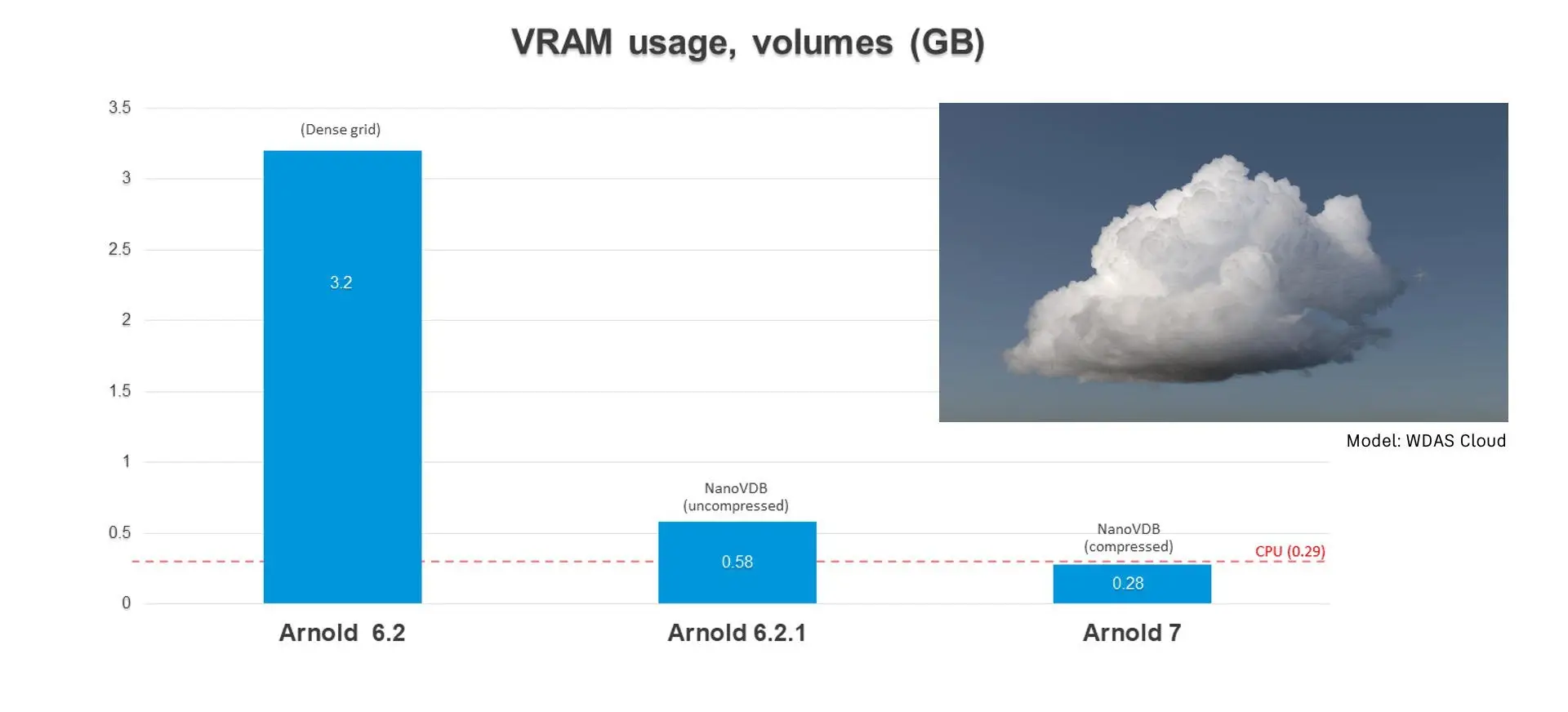Solid Angle Cinema 4D to Arnold 4.0.0.1 | 4.6 Gb
The software developer Solid Angle announced the launch of Arnold (C4DtoA) 4.0.0.1 for Cinema4D. This update uses Arnold 7.0.0.0 and is a major feature release adding ACEScg as the default rendering color space, Intel's Open Image Denoise, better denoising quality overall, important scalability improvements on GPU, and better performance and interactivity. This major release also introduces support to the Cinema 4D Node Material and Node Editor (still in beta), important changes in the Arnold API, such as the ability to render several scenes within the same process, and shaders now supporting multiple outputs. Support for Cinema 4D S22 is dropped.
4.0.0.1 release note - Date:18.10.2021
- Open Image Denoise imager: Intel's Open Image Denoise (OIDN) is a fast, AI-accelerated denoiser that runs on CPU that has been integrated into Arnold as the imager_denoiser_oidn imager as an additional denoising option. (ARNOLD-8677).
- Higher quality AI denoising: The OptiX and OIDN denoisers now use the newly introduced denoise_albedo_noisy AOV as the albedo feature AOV provided to the denoiser. This adds specular reflections and refractions to the albedo, which can improve denoiser quality. Below are comparisons between undenoised and Optix denoised with the old and new albedo AOV (ARNOLD-10812).
- LUT based tone mapping: imager_tonemap now supports a lut mode to apply LUT files in all the formats supported by OCIOv2 (cube, look, 3dl, clf among others). imager_tonemap.lut_filename specifies the file to load. Note that some LUTs assume a non-linear color space. To help with this, it is possible to specify a working color space in imager_tonemap.lut_working_color_space to convert to the specified space, apply the lut, and convert to linear or rendering color space again (ARNOLD-11084).
Automatic selection of box filtering with OIDN and OptiX denoisers: The OptiX and OIDN denoisers do not perform well with CPU rendering filters that span across multiple pixels. Arnold on CPU will now automatically force a box filter on outputs with filters with known issues when either of the denoisers are used (ARNOLD-10812).
Imager_color_curves: A new imager to control brightness and color curves has been added. Separate curves can be authored for each R, G, or B component, along with the main curve to control the overall luminance response. Curve interpolation and working color space can also be set as needed (ARNOLD-11161).
- imager_tonemap.mix: imager_tonemap now has an additional mix parameter. 0 preserves the input untouched and 1 applies the full node effect (ARNOLD-11172).
- Ignore imagers option: The global option ignore_imagers has been added to allow users to disable imager post-processing in a scene. This can be useful for debugging and can also be enabled via kick with the -ii flag. (ARNOLD-10720).
- Improved support for imagers shared by multiple drivers: All imagers, including the denoisers, can now be shared by drivers with different AOV inputs (ARNOLD-11087).
- Improved imagers refresh rate in IPR: Fullframe imagers will now be updated during rendering so that the imager chain result can be previewed before the entire image has been rendered. This replaces the previous behavior where in some cases we would have to delay the result until after the full frame had finished (ARNOLD-11203).
- Improved filter performance in progressive rendering: The performance of several filters, including the Triangle, Sinc, Blackman-Harris, Catmull-Rom, and Mitnet filters have been improved when rendering in progressive mode. In some cases, we have seen a 48% improvement in performance and a 20x improvement in memory usage (ARNOLD-10651).
- Added support for multiple parallel render sessions on CPU: Any Arnold universe can now be rendered using its own render session (only one render session per universe). Those render sessions can be executed in any order, even in parallel.
The existing API (AiBegin) creates a default universe and render session, which can be used or ignored. Additional universes can be created and destroyed as usual with their API, but there is a new API that allows creating/destroying and using render sessions:
AtUniverse* universe = AiUniverse();
AtRenderSession* rs = AiRenderSession(universe);
AiRenderBegin(rs);
. . .
AiRenderEnd(rs);
AiRenderSessionDestroy(rs);
AiUniverseDestroy(universe);
- Multiple outputs for shaders: Arnold now supports having multiple outputs for shader nodes. Shader outputs can be linked to inputs of other shader nodes in a .ass file or programmatically via the AiNodeLinkOutput() function by optionally specifying which output is desired when linking. When no output is specified, the node's default output parameter will be chosen, preserving Arnold's existing behavior.
Standard OSL language rules apply when specifying multiple OSL shader outputs. An example OSL shader with three color outputs could look like the following snippet and each output could be connected separately :
shader test_shader (output color result = color(1, 1, 1),
output color good = color(0, 0, 1),
output color bad = color(1, 0, 0))
{ … }
- Visible lights now transparent: The visible lights are now transparent, which matches the behavior of indirectly seen lights. This also has the benefit of allowing black parts of textured lights to be masked away. This is a look-breaking change to fix previously incorrect visible light behavior (ARNOLD-9070).
- kick ascii render mode: kick -ascii allows rendering directly into the terminal. This requires a 24-bit terminal with UTF-8 support. The windows terminal, most Linux terminals, and iTerm support this; Apple's Terminal does not. This will change the resolution of the render to fit within the console, so any images written to disk will likely be very small. Because it is so low res, telling kick to use a small bucket size is recommended, for instance by passing -bs 16 to kick. This can be useful for checking if a render on a remote machine is working (ARNOLD-11146).
- Render in ACEScg by default: Arnold will now use an OCIO color manager by default. This color manager will use the default OCIO configuration file. Arnold will render in the ACEScg color space by default. (ARNOLD-11246):
The rendering color space in Arnold 6 and older is scene-linear Rec.709-sRGB, it is possible to override the default OCIO color manager to revert back to the previous default color space. For example, you must pass the following argument to kick :
-set ai_default_color_manager_ocio.color_space_linear "scene-linear Rec.709-sRGB"
Arnold assumes tx files are in the rendering space, it is recommended to regenerate tx files when changing the rendering color space
- Standard OCIO configuration: Arnold now ships with a standard OCIO configuration exposing common color spaces used for rendering, such as ACEScg and scene-linear Rec.709-sRGB as well as the ACES 1.0 SDR-video ACES output transform for standard dynamic range video.This configuration is compatible with the default Maya 2022 OCIO configuration. (ARNOLD-11333):
- Multi-part EXR: The EXR driver can now render AOVs as separate images (parts) in a multi-part EXR file (merged AOVs, in contrast, renders AOVs as layers in a single-part EXR).
Multi-part works with either scanline or tiled EXRs and is enabled with the driver_exr.multipart boolean parameter.
Noice does not work with multi-part EXRs.
Write AOVs to multiple formats: It is now possible to output a single AOV in multiple different formats, for example, the following output string will now output the correct result (ARNOLD-11079).
outputs 2 1 STRING "RGBA FLOAT filter testrender" "RGBA RGB filter testrender2"
OSL UDIMs: OSL now uses the same code as Arnold's image node for resolving texture tags, such as UDIMs. This can make OSL texture lookups faster and increase the types of texture tags that can be used from OSL. (ARNOLD-9276).
SSS setnames with randomwalk: The sss_setname feature that allows subsurface effects to spread between distinct objects is now supported in the randomwalk mode on CPU (ARNOLD-8140).
- Use Existing TX: When options.texture_use_existing_tx is set to true, which is the default, Arnold will attempt to use the .tx version of a texture when available. The .tx file must be located in the same directory as the requested source texture and have the same name with the exception of the file extension. For instance, if "foo/bar/floor.png" is requested and "foo/bar/floor.tx" exists then "floor.tx" will be used. Arnold will ignore any requested colorspace conversions when the .tx file is used since we assume the .tx will have the colorspace transform baked in (ARNOLD-4107).
- Support for MaterialX v1.38: Arnold extends its MaterialX support to v1.38. As a part of this upgrade, looks and materials exported from Arnold will now be expressed as a combination of Nodes and Inputs departing from the previous standard of ShaderRefs and Params. Arnold will still be able to render MaterialX documents exported with earlier versions of Arnold however this may cause a look-breaking change.
- Cryptomatte 1.1.2: Cryptomatte has been updated to version 1.1.2 (ARNOLD-11270).
- Arnold shaders in the Cinema 4D Node Material (BETA): Arnold shaders are now available in the native Node Material within the Arnold node space in Cinema 4D R23 and above. The node graph can be edited via the native Node Editor. The feature is in beta state, see the known limitations below (C4DTOA-1940).
- Default material system in Preferences: New option is added to the Preference window, which controls whether the new Node Material (still in beta) or the old Arnold Material is created from the menus. (C4DTOA-2513)
- Reference shader in the Node Material: Reference shader is ported to the Node Material, which can reference another Node Material or an old Arnold Material. (C4DTOA-2401)
- ACEScg as the default render color space: Default render color space is now changed to the industry standard Academy Color Encoding System (ACES) via an OCIO v2 config shipped with Arnold. This change does not affect existing scenes which use the builtin (legacy) color manager (linear color space with sRGB primaries). (C4DTOA-2503)
- Bake texture into Picture Viewer output: New option is added to the render settings to bake the view color transform into the output saved in the Picture Viewer. This is needed to compensate for the built-in Cinema 4D color transform. Enable this option when saving to an 8-bit integer image (e.g. JPEG, PNG). Disable the option when saving to a 32-bit float image (e.g. EXR). This does not affect Arnold Drivers, only save from the Picture Viewer (including Commandline and Team Render). (C4DTOA-2540)
- Color space of Arnold Sky and Arnold Light color texture: Color space of a texture linked to the Arnold Sky or Arnold Light color (e.g. HDRI map) can be properly defined. In case of a 32-bit texture (e.g. .hdr) it defaults to linear color space with sRGB primaries (linear sRGB). (C4DTOA-2531)
- Color space aliases: New options are available when selecting color space of a texture: sRGB, linear sRGB, raw. These aliases resolve to the actual color spaces defined by the active color manager and allow smooth switching between color managers (e.g. legacy <-> default ACES) and managing material assets created with a specific color manager. (C4DTOA-2480)
- Set default color manager in Preferences: The default color manager can be overridden in the Preferences window. This is the color manager which is created in new scenes or new render settings by default. This can be useful when someone wants to use a custom OCIO config instead of the built-in one, or a custom color manager. Normally the default ACES config is fine and this option is not set. (C4DTOA-2471)
- LUT settings are removed from the IPR window: LUT settings are removed from the Display tab of the IPR window, use the tonemap imager instead. LUTs now apply to the Picture Viewer as well, not just the IPR. (C4DTOA-2386)
- Reduced VRAM use for polymeshes: The amount of VRAM used by polymeshes is significantly lower in this version. Scenes with heavy subdivision will use around 33% less GPU memory for geometry (ARNOLD-8524).
- Reduced VRAM use for GPU volumes: In 6.2.1 we started to use NVIDIA's NanoVDB system for rendering OpenVDB volumes on GPU, which greatly reduced the GPU memory required for OpenVDB volumes. In 7.0, compression of NanoVDB volumes has been further improved, so that we see roughly a further 50-60% reduction in GPU memory in typical volumetric scenes. GPU volumes now consume less VRAM than the equivalent CPU volumes consume RAM (note, the red line shows the RAM usage in a separate CPU render). (ARNOLD-11229)
- Matte support: Support for matte has been added to the GPU integrator. This means the matte closure, matte shader, and matte shape flag are all now supported (ARNOLD-7924).
- Reduced VRAM use for GPU volumes: In 6.2.1 we started to use NVIDIA's NanoVDB system for rendering OpenVDB volumes on GPU, which greatly reduced the GPU memory required for OpenVDB volumes. In 7.0, compression of NanoVDB volumes has been further improved, so that we see roughly a further 50-60% reduction in GPU memory in typical volumetric scenes. GPU volumes now consume less VRAM than the equivalent CPU volumes consume RAM (note, the red line shows the RAM usage in a separate CPU render). (ARNOLD-11229)
- Matte support: Support for matte has been added to the GPU integrator. This means the matte closure, matte shader, and matte shape flag are all now supported (ARNOLD-7924).
- USD 21.08: The procedural included in the core SDK is now built using USD 21.08.
- UsdImaging adapters: Arnold-USD now includes a set of UsdImaging adapters for Arnold specific schemas, that allows direct use of procedurals and Arnold shapes in Hydra. (usd#185 usd#741)
- Deep rendering: The render delegate now supports rendering of deep AOVs via DelegateRenderProducts. (usd#650)
- Multiple frames in a single file: The USD writer is now able to append multiple frames to a single USD file. (usd#777)
- Hydra scene delegate: Arnold-USD now includes an experimental scene delegate for Hydra. (usd#764)
- Progressive disabled when using Husk: Progressive rendering is now disabled when rendering via husk. (usd#755)
- Procedural Path Mapping: The procedural now supports Arnold Path Mapping when loading USD files. (usd#818)
- Custom PrimID Hydra Buffer: The render delegate now uses a dedicated primId AOV to support selections in Hydra viewports. This improves support for render-time procedurals and leaves the built-in id parameter unchanged on shapes. (usd#812)
- DoubleSided in the Render Delegate: The render delegate now supports the built-in doubleSided parameter on USD primitives and correctly supports overrides via Arnold-specific primvars. (usd#805)
- Motion Blur using Velocity and Acceleration: The render delegate now extrapolates point positions if velocity or acceleration primvars exist and there are no multiple samples for the position. (usd#673)
- Light Linking: The procedural now supports light linking. (usd#787)
- Fast camera updates: The render delegate now handles camera-only updates more efficiently, improving the first time to pixel. (usd#869)
- Standard Surface Fallback: The render delegate now uses a standard surface as a fallback, when no materials are assigned to a prim. (usd#861)
- UsdImaging adapters: Arnold-USD now includes a set of UsdImaging adapters for Arnold specific schemas, that allows direct use of procedurals and Arnold shapes in Hydra. (usd#185 usd#741)
- Deep rendering: The render delegate now supports rendering of deep AOVs via DelegateRenderProducts. (usd#650)
- Multiple frames in a single file: The USD writer is now able to append multiple frames to a single USD file. (usd#777)
- Hydra scene delegate: Arnold-USD now includes an experimental scene delegate for Hydra. (usd#764)
- Progressive disabled when using Husk: Progressive rendering is now disabled when rendering via husk. (usd#755)
- Procedural Path Mapping: The procedural now supports Arnold Path Mapping when loading USD files. (usd#818)
- Custom PrimID Hydra Buffer: The render delegate now uses a dedicated primId AOV to support selections in Hydra viewports. This improves support for render-time procedurals and leaves the built-in id parameter unchanged on shapes. (usd#812)
- DoubleSided in the Render Delegate: The render delegate now supports the built-in doubleSided parameter on USD primitives and correctly supports overrides via Arnold-specific primvars. (usd#805)
- Motion Blur using Velocity and Acceleration: The render delegate now extrapolates point positions if velocity or acceleration primvars exist and there are no multiple samples for the position. (usd#673)
- Light Linking: The procedural now supports light linking. (usd#787)
- Fast camera updates: The render delegate now handles camera-only updates more efficiently, improving the first time to pixel. (usd#869)
- Standard Surface Fallback: The render delegate now uses a standard surface as a fallback, when no materials are assigned to a prim. (usd#861)
- Removed denoise_optix_filter: With the introduction of the imager_denoiser_optix node, the old denoise_optix_filter code path has become redundant and therefore removed. (ARNOLD-11204)
- imager_denoiser_optix clamp disabled by default: The default of the imager_denoiser_optix's clamp parameter has now been set to disabled. (ARNOLD-11187)
- Support for MaterialX v1.38 : There's a look-breaking change that affects certain materialX documents. If your document contains a connection to a MaterialX nodeGraph without explicitly specifying the output of the nodegraph the node is connecting to, we used to be returning a NULL meaning so the connection was not applied. In this version, if this scenario exists we return the first output to the nodegraph.
- Multiple render sessions: For the API updated as described above, the old API was maintained as deprecated and is implicitly using the default universe/render session. This will work fine when using the default universe and render session, but any code expected to work on an arbitrary universe/render session will have to be updated with the new API passing an explicit universe or render session.
- options.pin_threads: pin_threads has been removed from the options node. Threads are now never pinned. (ARNOLD-11073)
- AiOutputIteratorGetNext: AiOutputIteratorGetNext switched from taking a const char** output_name to the more efficient AtString* output_name. (ARNOLD-11357)
- Removed source code info from API functions: AiMalloc_func(), AiFree_func(), AiRealloc_func(), AiArrayGet*Func(), and AiArraySet*Func() all took source code info (filename and line number). These functions have been removed and their previous macros (AiMalloc(), AiFree(), AiRealloc(), AiArrayGet*(), and AiArraySet()) which were setting the source code info are now proper functions. If you were using the macros you should not need to modify any code. (ARNOLD-5785, ARNOLD-10754).
- options.scene_units_in_meters: The scene_units_in_meters option and metadata have been renamed to meters_per_unit, putting them more in line with their equivalents in the USD standard. Note that these values now have an inverse interpretation to what they had before, so implementations must now provide values such that: new_scene_units_value = 1 / old_scene_units_value (ARNOLD-11176)
- Renamed AiUniverseIsActive to AiArnoldIsActive: The AiUniverseIsActive API function is now renamed to AiArnoldIsActive (ARNOLD-11120)
- Autodesk Network Licensing version: Arnold 7 switches to ARNOL_2022 licensing.
. Single-user subscriptions will work with Arnold 7. The plugin installers automatically register the new version. If you do not use a plugin, then after you download Arnold, open the Arnold License Manager and click Register.
. Existing network licenses will not work with Arnold 7. Log on to your Autodesk account to generate your new ARNOL_2022 licenses.
- imager_denoiser_optix clamp disabled by default: The default of the imager_denoiser_optix's clamp parameter has now been set to disabled. (ARNOLD-11187)
- Support for MaterialX v1.38 : There's a look-breaking change that affects certain materialX documents. If your document contains a connection to a MaterialX nodeGraph without explicitly specifying the output of the nodegraph the node is connecting to, we used to be returning a NULL meaning so the connection was not applied. In this version, if this scenario exists we return the first output to the nodegraph.
- Multiple render sessions: For the API updated as described above, the old API was maintained as deprecated and is implicitly using the default universe/render session. This will work fine when using the default universe and render session, but any code expected to work on an arbitrary universe/render session will have to be updated with the new API passing an explicit universe or render session.
- options.pin_threads: pin_threads has been removed from the options node. Threads are now never pinned. (ARNOLD-11073)
- AiOutputIteratorGetNext: AiOutputIteratorGetNext switched from taking a const char** output_name to the more efficient AtString* output_name. (ARNOLD-11357)
- Removed source code info from API functions: AiMalloc_func(), AiFree_func(), AiRealloc_func(), AiArrayGet*Func(), and AiArraySet*Func() all took source code info (filename and line number). These functions have been removed and their previous macros (AiMalloc(), AiFree(), AiRealloc(), AiArrayGet*(), and AiArraySet()) which were setting the source code info are now proper functions. If you were using the macros you should not need to modify any code. (ARNOLD-5785, ARNOLD-10754).
- options.scene_units_in_meters: The scene_units_in_meters option and metadata have been renamed to meters_per_unit, putting them more in line with their equivalents in the USD standard. Note that these values now have an inverse interpretation to what they had before, so implementations must now provide values such that: new_scene_units_value = 1 / old_scene_units_value (ARNOLD-11176)
- Renamed AiUniverseIsActive to AiArnoldIsActive: The AiUniverseIsActive API function is now renamed to AiArnoldIsActive (ARNOLD-11120)
- Autodesk Network Licensing version: Arnold 7 switches to ARNOL_2022 licensing.
. Single-user subscriptions will work with Arnold 7. The plugin installers automatically register the new version. If you do not use a plugin, then after you download Arnold, open the Arnold License Manager and click Register.
. Existing network licenses will not work with Arnold 7. Log on to your Autodesk account to generate your new ARNOL_2022 licenses.
C4DTOA-2555 HDR sky texture is displayed dark in the viewport
ARNOLD-3573 - Incorrect log color in Windows consoles when using multiple threads
ARNOLD-11625 - Empty backtrace when using printBackTrace() outside a crash on Windows
ARNOLD-11230 - Low transmission_depth values causes dielectrics to be too dark
ARNOLD-11421 - Progressive render IPR can get stuck at final AA level
ARNOLD-11178 - Unexpected normal smoothing behavior
ARNOLD-11228 - Using ray/shader switches to lower transmission depth causes dielectrics to be too dark
ARNOLD-11562 - [Alembic] UV data in curves not interpolated correctly when overriding curve.basis
ARNOLD-11361 - [Alembic] user data on curves is interpolated incorrectly
ARNOLD-8934 - [GPU] Arnold "Render Section to Texture" crashes Maya
ARNOLD-11687 - [GPU] 8-bit RGBA sRGB textures render incorrectly in ACEScg
ARNOLD-10996 - [GPU] Crash or artifacts when multiple image nodes point to the same texture
ARNOLD-11515 - [GPU] Crash when destroying procedurals interactively using 470 Nvidia drivers
ARNOLD-11621 - [GPU] Discrepancy with SSS closures in OSL
ARNOLD-11241 - [GPU] Missing alpha channel in RGBA-typed LPE AOVs
ARNOLD-11466 - [GPU] denoise_albedo is black on SSS
ARNOLD-11444 - [Imagers] Crash after an imager_denoiser_optix error
ARNOLD-11087 - [Imagers] Incorrect result when multiple drivers with different AOVs share a single imager
ARNOLD-11071 - [MaterialX] Crash when multiple objects share the same material
ARNOLD-11089 - [OCIO] OCIOColorManagerGetKnownChromaticities() not working with OCIO environment variable
ARNOLD-11538 - [OCIO] Random crashes when using the color API from multiple threads
ARNOLD-8521 - [OSL] UDIM textures through OSL do not have their color transform applied
ARNOLD-9190 - [Noice] Crash when using a small data window
usd#751 Render delegate crashes when changing material terminals interactively
usd#797 Warning messages when HdArnoldRenderPass is deleted
usd#847 Procedural should check the camera of the proper universe for motion blur settings
usd#858 Can't hide/unhide lights in Hydra
usd#853 Missing indices for facevarying primvars in Hydra abort renders
usd#871 Enforce writing multiple frames when no default is authored
ARNOLD-3573 - Incorrect log color in Windows consoles when using multiple threads
ARNOLD-11625 - Empty backtrace when using printBackTrace() outside a crash on Windows
ARNOLD-11230 - Low transmission_depth values causes dielectrics to be too dark
ARNOLD-11421 - Progressive render IPR can get stuck at final AA level
ARNOLD-11178 - Unexpected normal smoothing behavior
ARNOLD-11228 - Using ray/shader switches to lower transmission depth causes dielectrics to be too dark
ARNOLD-11562 - [Alembic] UV data in curves not interpolated correctly when overriding curve.basis
ARNOLD-11361 - [Alembic] user data on curves is interpolated incorrectly
ARNOLD-8934 - [GPU] Arnold "Render Section to Texture" crashes Maya
ARNOLD-11687 - [GPU] 8-bit RGBA sRGB textures render incorrectly in ACEScg
ARNOLD-10996 - [GPU] Crash or artifacts when multiple image nodes point to the same texture
ARNOLD-11515 - [GPU] Crash when destroying procedurals interactively using 470 Nvidia drivers
ARNOLD-11621 - [GPU] Discrepancy with SSS closures in OSL
ARNOLD-11241 - [GPU] Missing alpha channel in RGBA-typed LPE AOVs
ARNOLD-11466 - [GPU] denoise_albedo is black on SSS
ARNOLD-11444 - [Imagers] Crash after an imager_denoiser_optix error
ARNOLD-11087 - [Imagers] Incorrect result when multiple drivers with different AOVs share a single imager
ARNOLD-11071 - [MaterialX] Crash when multiple objects share the same material
ARNOLD-11089 - [OCIO] OCIOColorManagerGetKnownChromaticities() not working with OCIO environment variable
ARNOLD-11538 - [OCIO] Random crashes when using the color API from multiple threads
ARNOLD-8521 - [OSL] UDIM textures through OSL do not have their color transform applied
ARNOLD-9190 - [Noice] Crash when using a small data window
usd#751 Render delegate crashes when changing material terminals interactively
usd#797 Warning messages when HdArnoldRenderPass is deleted
usd#847 Procedural should check the camera of the proper universe for motion blur settings
usd#858 Can't hide/unhide lights in Hydra
usd#853 Missing indices for facevarying primvars in Hydra abort renders
usd#871 Enforce writing multiple frames when no default is authored
Arnold is an advanced cross-platform rendering library, or API, developed by Solid Angle and used by a number of prominent organizations in film, television and animation, including Sony Pictures Imageworks. It was developed as a photo-realistic, physically-based ray tracing alternative to traditional scanline based rendering software for CG animation.
Arnold uses cutting-edge algorithms that make the most effective use of your computer’s hardware resources: memory, disk space, multiple processor cores, and SIMD/SSE units.
The Arnold architecture was designed to easily adapt to existing pipelines. It is built on top of a pluggable node system; users can extend and customize the system by writing new shaders, cameras, filters and output driver nodes, as well as procedural geometry, custom ray types and user-defined geometric data. The primary goal of the Arnold architecture is to provide a complete solution as a primary renderer for animation and visual effects.
Arnold renderer
Arnold for Cinema4D (C4DtoA) supports most Cinema 4D features such as instances, cloners, deformers, generators, MoGraph geometry, hair, and ThinkingParticles. It also supports both animation and single frame distributed rendering in Team Render, allowing the use of all computers in a local network to speed-up Arnold rendering. Third-party plugins TurbulenceFD and X-Particles are natively supported, allowing artists to render high quality smoke, fire, and particle effects with fully interactive feedback. Other features include volume rendering with OpenVDB, a node-based material editor and a comprehensive list of shaders and utilities, including vertex maps and per-face materials.
HOW TO Realistic Shaders in Cinema 4d and Arnold | Plastic, Wood, Concrete and Metal | Tutorial
Solid Angle SL is the technology company behind the Arnold rendering software, with offices in Madrid and London and customers throughout the world including Framestore, DreamWorks, ILM, Sony Pictures Imageworks, MPC, The Mill, Mikros Image and Rising Sun Pictures. Arnold was designed from the ground up to efficiently raytrace the complex geometric datasets required for feature-length CGI animation and big budget visual effects, while at the same time simplifying the pipeline, reducing the number of passes, minimizing storage requirements and greatly enhancing interactivity for lighting artists.
Product: Solid Angle Cinema4D to Arnold
Version: 4.0.0.1
Supported Architectures: x64
Website Home Page : www.arnoldrenderer.com
Languages Supported: english
System Requirements: PC / macOs *
Size: 4.6 Gb
Requirements & Platforms
Supported Cinema 4D versions:
- R21.026 and above
- S22.016 and above ( Official support for Cinema 4D S22 is discontinued, but direct links to compiled versions of "C4DtoA 4.0.0.1" for S22 are still available)
- R23.008 and above
- S24.111 and above
- R25.010 and above
- Windows 10 or later, with the Visual Studio 2019 redistributable.
- macOS 10.13 or later
- Apple Mac models with M series chip are supported under Rosetta 2 mode
- CPUs need to support the SSE4.1 instruction set.
- GPU rendering works on Windows and Linux only and requires an NVIDIA GPU of the Ampere, Turing, Volta, Pascal, or Maxwell architecture. We recommend using the 460.39 or higher drivers on Linux and 461.40 (Quadro), 461.40 (GeForce), or higher on Windows. See Getting Started with Arnold GPU for more information.
- Optix denoiser requires an NVidia GPU with CUDA Compute Capability 5.0 and above.
Supported Cinema 4D versions:
- R21.026 and above
- S22.016 and above ( Official support for Cinema 4D S22 is discontinued, but direct links to compiled versions of "C4DtoA 4.0.0.1" for S22 are still available)
- R23.008 and above
- S24.111 and above
- R25.010 and above
- Windows 10 or later, with the Visual Studio 2019 redistributable.
- macOS 10.13 or later
- Apple Mac models with M series chip are supported under Rosetta 2 mode
- CPUs need to support the SSE4.1 instruction set.
- GPU rendering works on Windows and Linux only and requires an NVIDIA GPU of the Ampere, Turing, Volta, Pascal, or Maxwell architecture. We recommend using the 460.39 or higher drivers on Linux and 461.40 (Quadro), 461.40 (GeForce), or higher on Windows. See Getting Started with Arnold GPU for more information.
- Optix denoiser requires an NVidia GPU with CUDA Compute Capability 5.0 and above.
Please visit my blog
Added by 3% of the overall size of the archive of information for the restoration
No mirrors please
Added by 3% of the overall size of the archive of information for the restoration
No mirrors please


